Wei Guo
and Other Contributors
FoMo4Wheat: Toward reliable crop vision foundation models with globally curated data
Sep 08, 2025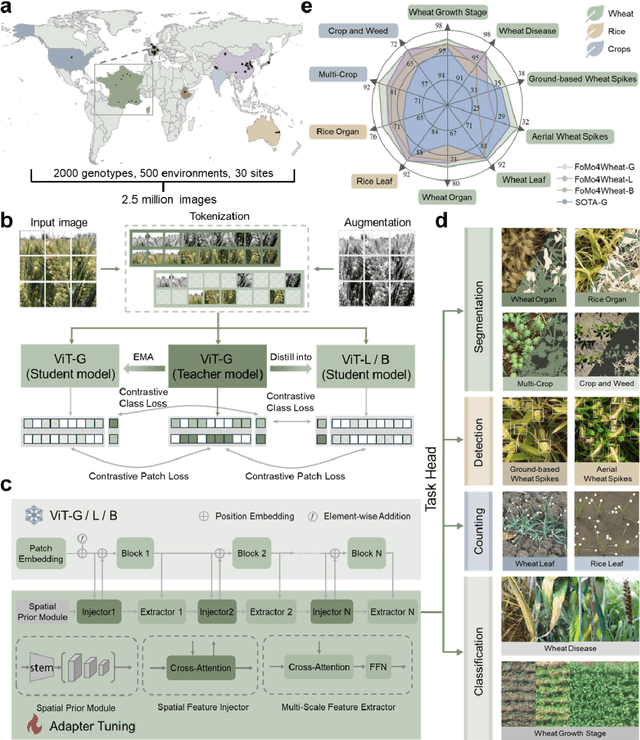
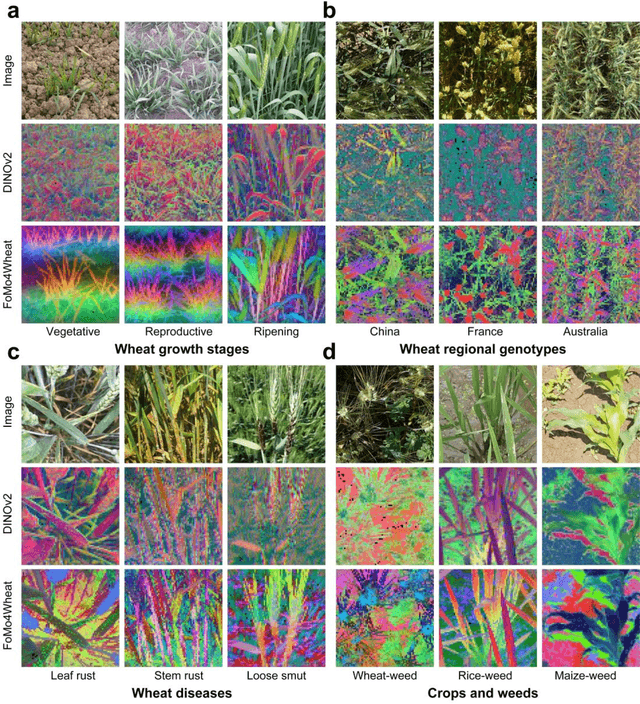
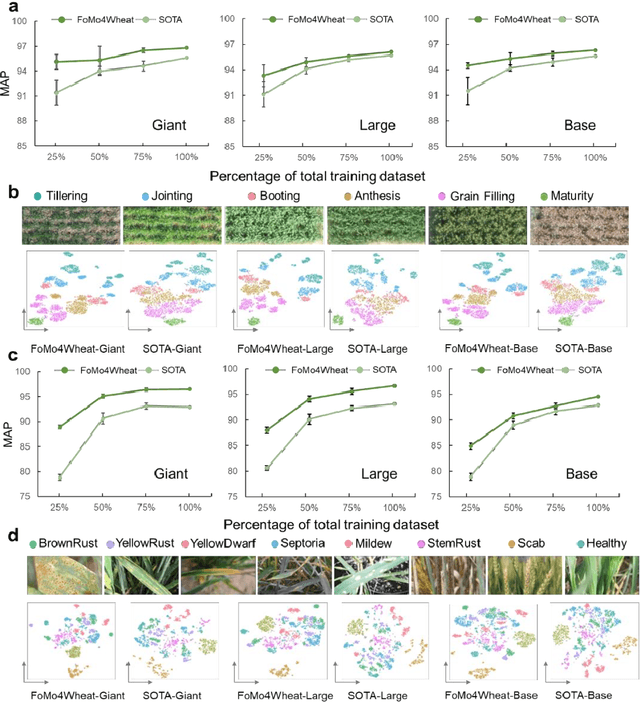
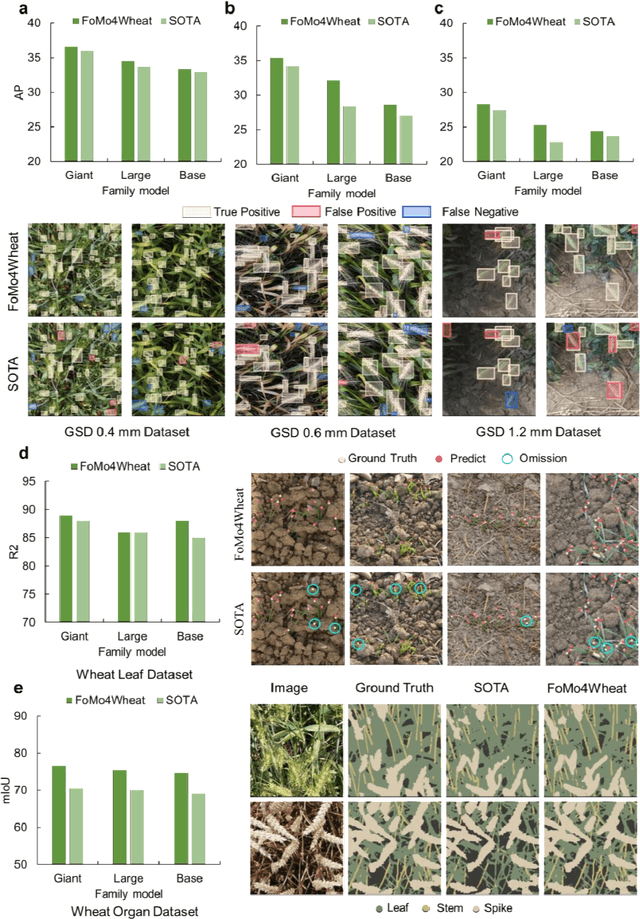
Abstract:Vision-driven field monitoring is central to digital agriculture, yet models built on general-domain pretrained backbones often fail to generalize across tasks, owing to the interaction of fine, variable canopy structures with fluctuating field conditions. We present FoMo4Wheat, one of the first crop-domain vision foundation model pretrained with self-supervision on ImAg4Wheat, the largest and most diverse wheat image dataset to date (2.5 million high-resolution images collected over a decade at 30 global sites, spanning >2,000 genotypes and >500 environmental conditions). This wheat-specific pretraining yields representations that are robust for wheat and transferable to other crops and weeds. Across ten in-field vision tasks at canopy and organ levels, FoMo4Wheat models consistently outperform state-of-the-art models pretrained on general-domain dataset. These results demonstrate the value of crop-specific foundation models for reliable in-field perception and chart a path toward a universal crop foundation model with cross-species and cross-task capabilities. FoMo4Wheat models and the ImAg4Wheat dataset are publicly available online: https://github.com/PheniX-Lab/FoMo4Wheat and https://huggingface.co/PheniX-Lab/FoMo4Wheat. The demonstration website is: https://fomo4wheat.phenix-lab.com/.
Proto-EVFL: Enhanced Vertical Federated Learning via Dual Prototype with Extremely Unaligned Data
Jul 30, 2025Abstract:In vertical federated learning (VFL), multiple enterprises address aligned sample scarcity by leveraging massive locally unaligned samples to facilitate collaborative learning. However, unaligned samples across different parties in VFL can be extremely class-imbalanced, leading to insufficient feature representation and limited model prediction space. Specifically, class-imbalanced problems consist of intra-party class imbalance and inter-party class imbalance, which can further cause local model bias and feature contribution inconsistency issues, respectively. To address the above challenges, we propose Proto-EVFL, an enhanced VFL framework via dual prototypes. We first introduce class prototypes for each party to learn relationships between classes in the latent space, allowing the active party to predict unseen classes. We further design a probabilistic dual prototype learning scheme to dynamically select unaligned samples by conditional optimal transport cost with class prior probability. Moreover, a mixed prior guided module guides this selection process by combining local and global class prior probabilities. Finally, we adopt an \textit{adaptive gated feature aggregation strategy} to mitigate feature contribution inconsistency by dynamically weighting and aggregating local features across different parties. We proved that Proto-EVFL, as the first bi-level optimization framework in VFL, has a convergence rate of 1/\sqrt T. Extensive experiments on various datasets validate the superiority of our Proto-EVFL. Even in a zero-shot scenario with one unseen class, it outperforms baselines by at least 6.97%
H2Tune: Federated Foundation Model Fine-Tuning with Hybrid Heterogeneity
Jul 30, 2025Abstract:Different from existing federated fine-tuning (FFT) methods for foundation models, hybrid heterogeneous federated fine-tuning (HHFFT) is an under-explored scenario where clients exhibit double heterogeneity in model architectures and downstream tasks. This hybrid heterogeneity introduces two significant challenges: 1) heterogeneous matrix aggregation, where clients adopt different large-scale foundation models based on their task requirements and resource limitations, leading to dimensional mismatches during LoRA parameter aggregation; and 2) multi-task knowledge interference, where local shared parameters, trained with both task-shared and task-specific knowledge, cannot ensure only task-shared knowledge is transferred between clients. To address these challenges, we propose H2Tune, a federated foundation model fine-tuning with hybrid heterogeneity. Our framework H2Tune consists of three key components: (i) sparsified triple matrix decomposition to align hidden dimensions across clients through constructing rank-consistent middle matrices, with adaptive sparsification based on client resources; (ii) relation-guided matrix layer alignment to handle heterogeneous layer structures and representation capabilities; and (iii) alternating task-knowledge disentanglement mechanism to decouple shared and specific knowledge of local model parameters through alternating optimization. Theoretical analysis proves a convergence rate of O(1/\sqrt{T}). Extensive experiments show our method achieves up to 15.4% accuracy improvement compared to state-of-the-art baselines. Our code is available at https://anonymous.4open.science/r/H2Tune-1407.
RoboBrain 2.0 Technical Report
Jul 02, 2025Abstract:We introduce RoboBrain 2.0, our latest generation of embodied vision-language foundation models, designed to unify perception, reasoning, and planning for complex embodied tasks in physical environments. It comes in two variants: a lightweight 7B model and a full-scale 32B model, featuring a heterogeneous architecture with a vision encoder and a language model. Despite its compact size, RoboBrain 2.0 achieves strong performance across a wide spectrum of embodied reasoning tasks. On both spatial and temporal benchmarks, the 32B variant achieves leading results, surpassing prior open-source and proprietary models. In particular, it supports key real-world embodied AI capabilities, including spatial understanding (e.g., affordance prediction, spatial referring, trajectory forecasting) and temporal decision-making (e.g., closed-loop interaction, multi-agent long-horizon planning, and scene graph updating). This report details the model architecture, data construction, multi-stage training strategies, infrastructure and practical applications. We hope RoboBrain 2.0 advances embodied AI research and serves as a practical step toward building generalist embodied agents. The code, checkpoint and benchmark are available at https://superrobobrain.github.io.
Joint Transmit and Receive Beamforming for Tri-directional Coil-Based Magnetic Induction Communications
May 30, 2025Abstract:In this paper, we enhance the omnidirectional coverage performance of tri-directional coil-based magnetic induction communication (TC-MIC) and reduce the pathloss with a joint transmit and receive magnetic beamforming method. An iterative optimization algorithm incorporating the transmit current vector and receive weight matrix is developed to minimize the pathloss under constant transmit power constraints. We formulate the mathematical models for the mutual inductance of tri-directional coils, receive power, and pathloss. The optimization problem is decomposed into Rayleigh quotient extremum optimization for transmit currents and Cauchy-Schwarz inequality-constrained optimization for receive weights, with an alternating iterative algorithm to approach the global optimum. Numerical results demonstrate that the proposed algorithm converges within an average of 13.6 iterations, achieving up to 54% pathloss reduction compared with equal power allocation schemes. The joint optimization approach exhibits superior angular robustness, maintaining pathloss fluctuation smaller than 2 dB, and reducing fluctuation of pathloss by approximately 45% compared with single-parameter optimization methods.
Pangu Pro MoE: Mixture of Grouped Experts for Efficient Sparsity
May 28, 2025Abstract:The surgence of Mixture of Experts (MoE) in Large Language Models promises a small price of execution cost for a much larger model parameter count and learning capacity, because only a small fraction of parameters are activated for each input token. However, it is commonly observed that some experts are activated far more often than others, leading to system inefficiency when running the experts on different devices in parallel. Therefore, we introduce Mixture of Grouped Experts (MoGE), which groups the experts during selection and balances the expert workload better than MoE in nature. It constrains tokens to activate an equal number of experts within each predefined expert group. When a model execution is distributed on multiple devices, this architectural design ensures a balanced computational load across devices, significantly enhancing throughput, particularly for the inference phase. Further, we build Pangu Pro MoE on Ascend NPUs, a sparse model based on MoGE with 72 billion total parameters, 16 billion of which are activated for each token. The configuration of Pangu Pro MoE is optimized for Ascend 300I Duo and 800I A2 through extensive system simulation studies. Our experiments indicate that MoGE indeed leads to better expert load balancing and more efficient execution for both model training and inference on Ascend NPUs. The inference performance of Pangu Pro MoE achieves 1148 tokens/s per card and can be further improved to 1528 tokens/s per card by speculative acceleration, outperforming comparable 32B and 72B Dense models. Furthermore, we achieve an excellent cost-to-performance ratio for model inference on Ascend 300I Duo. Our studies show that Ascend NPUs are capable of training Pangu Pro MoE with massive parallelization to make it a leading model within the sub-100B total parameter class, outperforming prominent open-source models like GLM-Z1-32B and Qwen3-32B.
DLF: Enhancing Explicit-Implicit Interaction via Dynamic Low-Order-Aware Fusion for CTR Prediction
May 25, 2025Abstract:Click-through rate (CTR) prediction is a critical task in online advertising and recommender systems, relying on effective modeling of feature interactions. Explicit interactions capture predefined relationships, such as inner products, but often suffer from data sparsity, while implicit interactions excel at learning complex patterns through non-linear transformations but lack inductive biases for efficient low-order modeling. Existing two-stream architectures integrate these paradigms but face challenges such as limited information sharing, gradient imbalance, and difficulty preserving low-order signals in sparse CTR data. We propose a novel framework, Dynamic Low-Order-Aware Fusion (DLF), which addresses these limitations through two key components: a Residual-Aware Low-Order Interaction Network (RLI) and a Network-Aware Attention Fusion Module (NAF). RLI explicitly preserves low-order signals while mitigating redundancy from residual connections, and NAF dynamically integrates explicit and implicit representations at each layer, enhancing information sharing and alleviating gradient imbalance. Together, these innovations balance low-order and high-order interactions, improving model expressiveness. Extensive experiments on public datasets demonstrate that DLF achieves state-of-the-art performance in CTR prediction, addressing key limitations of existing models. The implementation is publicly available at https://github.com/USTC-StarTeam/DLF.
Fluid Antenna-Assisted MU-MIMO Systems with Decentralized Baseband Processing
May 08, 2025Abstract:The fluid antenna system (FAS) has emerged as a disruptive technology, offering unprecedented degrees of freedom (DoF) for wireless communication systems. However, optimizing fluid antenna (FA) positions entails significant computational costs, especially when the number of FAs is large. To address this challenge, we introduce a decentralized baseband processing (DBP) architecture to FAS, which partitions the FA array into clusters and enables parallel processing. Based on the DBP architecture, we formulate a weighted sum rate (WSR) maximization problem through joint beamforming and FA position design for FA-assisted multiuser multiple-input multiple-output (MU-MIMO) systems. To solve the WSR maximization problem, we propose a novel decentralized block coordinate ascent (BCA)-based algorithm that leverages matrix fractional programming (FP) and majorization-minimization (MM) methods. The proposed decentralized algorithm achieves low computational, communication, and storage costs, thus unleashing the potential of the DBP architecture. Simulation results show that our proposed algorithm under the DBP architecture reduces computational time by over 70% compared to centralized architectures with negligible WSR performance loss.
Accurate and Fast Channel Estimation for Fluid Antenna Systems with Diffusion Models
May 08, 2025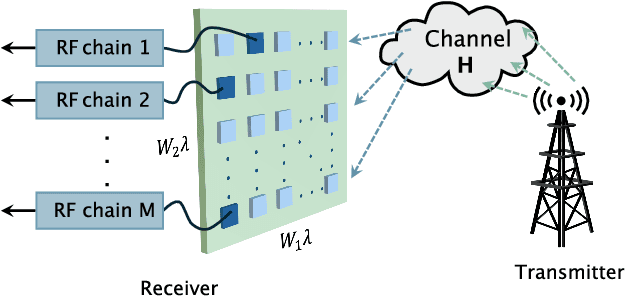
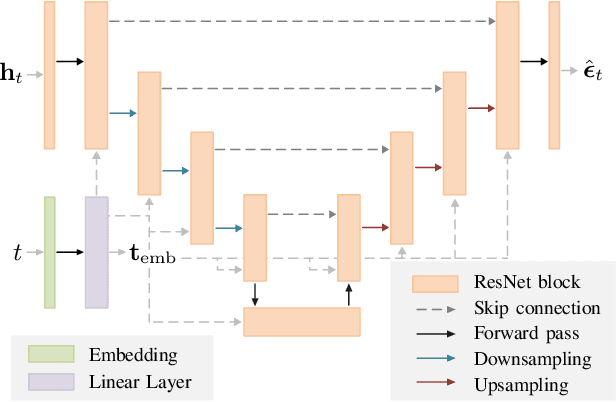
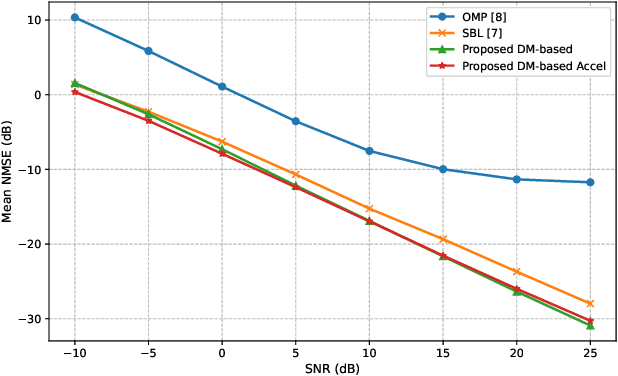
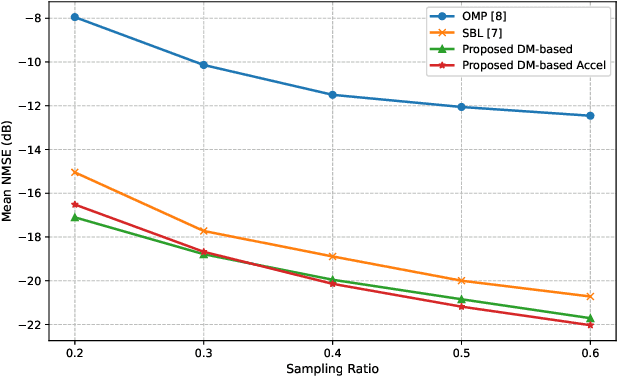
Abstract:Fluid antenna systems (FAS) offer enhanced spatial diversity for next-generation wireless systems. However, acquiring accurate channel state information (CSI) remains challenging due to the large number of reconfigurable ports and the limited availability of radio-frequency (RF) chains -- particularly in high-dimensional FAS scenarios. To address this challenge, we propose an efficient posterior sampling-based channel estimator that leverages a diffusion model (DM) with a simplified U-Net architecture to capture the spatial correlation structure of two-dimensional FAS channels. The DM is initially trained offline in an unsupervised way and then applied online as a learned implicit prior to reconstruct CSI from partial observations via posterior sampling through a denoising diffusion restoration model (DDRM). To accelerate the online inference, we introduce a skipped sampling strategy that updates only a subset of latent variables during the sampling process, thereby reducing the computational cost with minimal accuracy degradation. Simulation results demonstrate that the proposed approach achieves significantly higher estimation accuracy and over 20x speedup compared to state-of-the-art compressed sensing-based methods, highlighting its potential for practical deployment in high-dimensional FAS.
Pangu Ultra MoE: How to Train Your Big MoE on Ascend NPUs
May 07, 2025Abstract:Sparse large language models (LLMs) with Mixture of Experts (MoE) and close to a trillion parameters are dominating the realm of most capable language models. However, the massive model scale poses significant challenges for the underlying software and hardware systems. In this paper, we aim to uncover a recipe to harness such scale on Ascend NPUs. The key goals are better usage of the computing resources under the dynamic sparse model structures and materializing the expected performance gain on the actual hardware. To select model configurations suitable for Ascend NPUs without repeatedly running the expensive experiments, we leverage simulation to compare the trade-off of various model hyperparameters. This study led to Pangu Ultra MoE, a sparse LLM with 718 billion parameters, and we conducted experiments on the model to verify the simulation results. On the system side, we dig into Expert Parallelism to optimize the communication between NPU devices to reduce the synchronization overhead. We also optimize the memory efficiency within the devices to further reduce the parameter and activation management overhead. In the end, we achieve an MFU of 30.0% when training Pangu Ultra MoE, with performance comparable to that of DeepSeek R1, on 6K Ascend NPUs, and demonstrate that the Ascend system is capable of harnessing all the training stages of the state-of-the-art language models. Extensive experiments indicate that our recipe can lead to efficient training of large-scale sparse language models with MoE. We also study the behaviors of such models for future reference.
 Add to Chrome
Add to Chrome Add to Firefox
Add to Firefox Add to Edge
Add to Edge